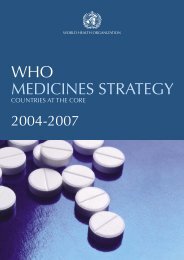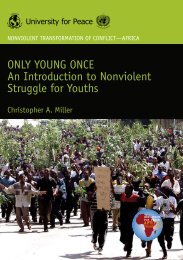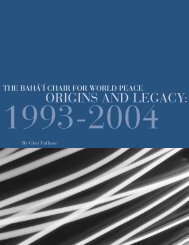IntroductionTHE erosion <strong>of</strong> clay and gardud soils and the depletion <strong>of</strong> productive lands <strong>in</strong>the greater region <strong>of</strong> Darfur and particularly <strong>in</strong> northern Darfur <strong>as</strong> a result <strong>of</strong>a relentless desertification process over the p<strong>as</strong>t several decades, compelleda forced ecological migration and m<strong>as</strong>s population movement southward <strong>in</strong> search<strong>of</strong> better conditions for p<strong>as</strong>ture and farm<strong>in</strong>g. The ability <strong>of</strong> local people to adaptto the new realities and the subsequent questions <strong>of</strong> land use and resource shar<strong>in</strong>gcont<strong>in</strong>ued to threaten peaceful coexistence <strong>in</strong> the area and the social cohesion<strong>of</strong> the entire community. The situation w<strong>as</strong> dest<strong>in</strong>ed to <strong>in</strong>cite local tensions andprovoke violent resource-b<strong>as</strong>ed <strong>conflict</strong>s. Ecological imbalance, scarcity <strong>of</strong> water,deforestation, mismanagement <strong>of</strong> natural resources, claimed <strong>in</strong>equality <strong>in</strong> the distribution<strong>of</strong> available resources and national projects, and the lack <strong>of</strong> cooperationhave contributed significantly to the present <strong>conflict</strong>.To explore the <strong>in</strong>terrelationships between <strong>environmental</strong> depletion and the crisis<strong>in</strong> Darfur, the University for Peace (UPEACE) <strong>in</strong> collaboration with the Peace ResearchInstitute held a conference on Environmental Degradation and the Conflict<strong>in</strong> Darfur, <strong>in</strong> Sharjah Hall at the University <strong>of</strong> Khartoum, 15-16 December 2004.It brought together a diverse group <strong>of</strong> stakeholders. There were one hundred andthirteen participants from various sectors <strong>in</strong>clud<strong>in</strong>g <strong>in</strong>stitutions <strong>of</strong> higher learn<strong>in</strong>g,civil society, women and youth groups, and advocacy organisations. The first sessionw<strong>as</strong> attended by two hundred and four persons, <strong>in</strong>clud<strong>in</strong>g the core participantsand observers from <strong>in</strong>ternational organisations, diplomats from foreign emb<strong>as</strong>sies<strong>in</strong> Khartoum, and the United Nations Advance Mission <strong>in</strong> Sudan (UNAMIS).Bakri Saeed and Altayeb Ateya preceded the hold<strong>in</strong>g <strong>of</strong> the conference with severalconsultative meet<strong>in</strong>gs, dur<strong>in</strong>g which they selected an advisory body <strong>of</strong> experts<strong>in</strong> environment, <strong>conflict</strong> resolution and issues <strong>of</strong> geopolitical economy and society<strong>in</strong> Darfur. The committee also <strong>in</strong>cluded former prov<strong>in</strong>cial governors, governmentm<strong>in</strong>isters, and amb<strong>as</strong>sadors with knowledge and experience <strong>in</strong> political and adm<strong>in</strong>istrativeaffairs, <strong>in</strong> addition to <strong>in</strong>ternational civil servants who had worked for UNbodies and <strong>in</strong>ternational organisations. In addition to those who had previouslyengaged <strong>in</strong> bilateral cooperative ventures <strong>in</strong> related fields. The conference advisorycommittee provided support <strong>in</strong> terms <strong>of</strong> promot<strong>in</strong>g the idea <strong>of</strong> the conference,develop<strong>in</strong>g the theme <strong>of</strong> the meet<strong>in</strong>g, choos<strong>in</strong>g the ma<strong>in</strong> topics, suggest<strong>in</strong>g names<strong>of</strong> speakers and discussants, sett<strong>in</strong>g the provisional shape <strong>of</strong> the programme, mak<strong>in</strong>guseful contacts with resource and key persons and mak<strong>in</strong>g their p<strong>as</strong>t academiccontributions and documentation available for frequent consultation by organisersand participants.Open<strong>in</strong>g and key speeches delivered by Bakri Saeed, Mary E. K<strong>in</strong>g, Altayeb HagAteya and Mohamed Ahmed Elshikh, the Vice Chancellor <strong>of</strong> Khartoum University, set12
the theme <strong>of</strong> the conference, outl<strong>in</strong>ed the objectives, made an <strong>in</strong>troduction to the<strong>conflict</strong> <strong>in</strong> Darfur and the recent developments, highlighted peace-build<strong>in</strong>g strategiesand backgrounds, and prepared the ground for scholarly and straight-th<strong>in</strong>k<strong>in</strong>gdeliberations. In addition to the comprehensive exploration <strong>of</strong> the situation <strong>in</strong>Darfur, l<strong>in</strong>ks were established to <strong>in</strong>ternational concerns and essential documentssuch <strong>as</strong> the Millennium Development Goals, the report on Responsibility to Protect,the United Nations Convention to Combat Desertification (UNCCD), the UN Secretary-General’s report on Causes <strong>of</strong> Conflict <strong>in</strong> Africa and the High-Level Panel on Threats,Challenges and Change. Special reference w<strong>as</strong> made by Dr Mary E. K<strong>in</strong>g, who spokeon peace build<strong>in</strong>g <strong>as</strong> a bridge between <strong>conflict</strong> resolution and peace, to the report<strong>of</strong> Secretary-General’s High-Level Panel, which had been rele<strong>as</strong>ed two weeks priorto the conference, on 1 December 2004, which states that <strong>environmental</strong> <strong>degradation</strong>results <strong>in</strong> the kill<strong>in</strong>g <strong>of</strong> millions every year and threatens human security.Follow<strong>in</strong>g the end <strong>of</strong> the conference, Dr Saeed, Dr K<strong>in</strong>g, and Abduljabar Abdalla,Vice Chancellor <strong>of</strong> the University <strong>of</strong> El-F<strong>as</strong>hir, held a press conference at the MeridienHotel <strong>in</strong> Kharoum. The conference w<strong>as</strong> attended by approximately twentyjournalists represent<strong>in</strong>g daily newspapers, radio, and television. The Blue Nile TVChannel covered the news conference, provid<strong>in</strong>g a comprehensive report <strong>in</strong>clud<strong>in</strong>g<strong>in</strong>terviews with the organisers. The three speakers at the news conferencepresented the f<strong>in</strong>d<strong>in</strong>gs <strong>of</strong> the meet<strong>in</strong>g and responded to the questions from mediarepresentatives.Objectives <strong>of</strong> the Meet<strong>in</strong>gInternal actors and the <strong>in</strong>ternational community are exert<strong>in</strong>g substantial effortsto resolve the immediate issues <strong>of</strong> the deadly crisis <strong>in</strong> Darfur – a region the size<strong>of</strong> France with a population <strong>of</strong> more than five million. Such labours fall <strong>in</strong>to threecategories: humanitarian <strong>as</strong>sistance, improvement <strong>in</strong> the security situation to allowthe safe return <strong>of</strong> refugees, and attempts to reach a political settlement betweenthe rebel groups and the government <strong>of</strong> Sudan. These efforts may eventually resolvethe present crisis; yet they leave the door open for further acute <strong>conflict</strong>s.It is therefore essential to address the root <strong>cause</strong>s <strong>of</strong> the problem – competitionover depleted natural resources, desertification, water scarcity, and <strong>environmental</strong>depletion. Hence the conference on Environmental Degradation and the Conflict <strong>in</strong>Darfur w<strong>as</strong> expected to achieve the follow<strong>in</strong>g objectives:• To provide a platform for the <strong>in</strong>terrogation <strong>of</strong> the major issues related to <strong>environmental</strong><strong>degradation</strong> and land use <strong>in</strong> Darfur, thus allow<strong>in</strong>g academics and13
- Page 1: ENVIRONMENTAL DEGRADATIONAS A CAUSE
- Page 4 and 5: Cover Photo:AU forces patrol Darfur
- Page 7 and 8: PREFACEThese essays were originally
- Page 9 and 10: AcknowledgementsThe conference was
- Page 11: Executive SummaryByMary E. King and
- Page 15 and 16: • The question of warrior culture
- Page 17 and 18: Deryke Belshaw, University of East
- Page 19 and 20: area in West Darfur of 1.5m feddans
- Page 21 and 22: on the interaction between conflict
- Page 23 and 24: Conflict In DarfurHistorical andCon
- Page 25 and 26: distributive centre and where the r
- Page 28 and 29: sues quite separate. Evidence for t
- Page 30 and 31: FOOTNOTES1It is not my purpose here
- Page 32 and 33: 20On other emerging ethnically-base
- Page 34 and 35: IntroductionTHE Greater Darfur regi
- Page 36 and 37: 2. Agriculture (Farming)Crop farmin
- Page 38 and 39: Secondly, the demand for mutton and
- Page 40 and 41: groundnut and sesame as sources of
- Page 42 and 43: The situation of drinking water in
- Page 44 and 45: ReferencesConference, Meleet, North
- Page 46 and 47: IntroductionTHE residents of the Um
- Page 48 and 49: Phase Two:This phase was a monitori
- Page 50 and 51: zone southward — and to use these
- Page 52 and 53: • Some water points in places lik
- Page 54 and 55: This study and the seminar organize
- Page 57 and 58: Land Tenure,Land Use andConflicts i
- Page 59 and 60: tain innovations called hakura (pl.
- Page 61 and 62: mands for food production. All thes
- Page 63 and 64:
Hashab Tenure SystemHashab ownershi
- Page 65 and 66:
co-exist at the local level where e
- Page 67 and 68:
IndigenousInstitutions andPractices
- Page 69 and 70:
abs. In the past they had been invo
- Page 71 and 72:
Sufi OrderSufi orders are religious
- Page 73 and 74:
Native Administration, i.e. Tribal
- Page 75 and 76:
Rizayqat homeland is at the extreme
- Page 77 and 78:
esearchers and statesmen. A bigger
- Page 79:
ReferencesBakheit, Jaafar M.Ali. 19
- Page 82 and 83:
IntroductionWHILE in the Sudan prot
- Page 84 and 85:
ReferencesHarir, S. 1993. ‘Arab B
- Page 86 and 87:
IntroductionTHE Darfur Region lies
- Page 88 and 89:
Table (1)Water program for Darfur 2
- Page 90 and 91:
anging from 150mm the north and 450
- Page 92 and 93:
ReferencesIbrahim, Abdel Rahman Abb
- Page 94 and 95:
CONCLUSIONTHE collection of papers
- Page 96 and 97:
GLOSSARYAjawidArdaBaqqaraDarDukhnFa
- Page 99 and 100:
A Darfur Timeline99
- Page 101 and 102:
1898 On the eve of the battle of Om
- Page 103 and 104:
Bibliography103
- Page 105 and 106:
El Mahdi S. Mohamed. 1979. Introduc
- Page 107 and 108:
Tothill, J.D. 1948. Agriculture in
- Page 109 and 110:
Biographical Sketch: Rex Sean O’F
- Page 111 and 112:
111











